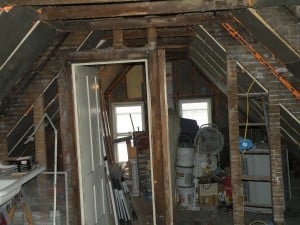It’s amazing to me that it is still acceptable in the building code to insulate homes with fiberglass batt insulation in colder climates. With cold temperatures for close to half the year and steadily increasing energy costs, there is certainly a need to be more creative about how we design, build, and insulate our living and working spaces.
ReUse Action just finished a project on the lower west side using reclaimed rigid foam insulation. We were hired to insulate the attic space in a standard Buffalo double. The attic space will be utilized in the future, so we chose to insulate between the rafters. Foam products give you the highest R-value rating per inch of any other insulation currently available. The R-value rating refers to the resistance to heat flow of the material. As a general rule, the higher the R-value, the higher the materials resistance to heat loss, meaning you keep the warm air IN, during the winter months and OUT during the summer months. 
Rigid foam offers an R-value of 5-6/inch, compared to 3/inch for fiberglass or dense pack cellulose. It also offers superior protection against infiltration of outside air into your living space. Therefore, in a 6 inch cavity, we were able to achieve an R-value that exceeded 35. We noticed a big difference in the interior air temperature after just one day of work and the space was no longer drafty. This strategy isn’t perfect. We went through after installing the foam and used a spray foam product to seal all the cracks and seams, but there will still be some heat loss through the rafters themselves. Thermal bridging refers to the loss of heat through the rafters that have a lower R-value than the surrounding foam (approximately R-1/inch). Two remedy this situation we could cover the face of all rafters with 1″ foam, prior to the installation of drywall. Still, even with the some thermal bridging, this rigid foam system will make a dramatic impact on the amount of heat lost from the building.
Another great thing about the foam we used is that it was a reclaimed foam sheets. This is material that would have gone to the landfill. We were able to secure the material and cut the material cost of the project by over two-thirds; this offered tremendous savings for our clients. 
ReUse Action is also now selling reclaimed rigid foam here in Buffalo. We can sell it to you directly, or offer you an estimate for a insulation project at your home or business. If you’re interested in purchasing some foam, feel free to contact us.
We also will be partnering with Cyd Cox of Ecologic Home to assist our clients in obtaining home energy audits. Your audit will result in recommendations for improving your home’s energy efficiency with prices for work suggested. You may also qualify for specific tax incentives, rebates, or low interest loans to assist you in getting the work done.
Even folks on a very tight budget can benefit from NYSERDA’s programs. Energy audits can help identify the major heat losses in your home and make recommendations to remedy them. An energy audit is the best place to start in making a move towards lower monthly energy expenses.
